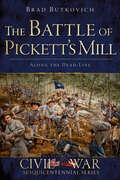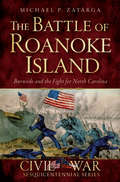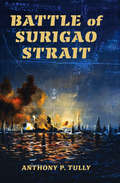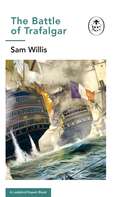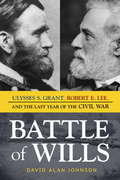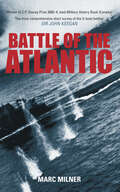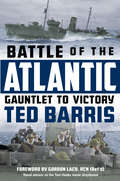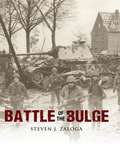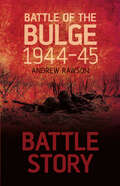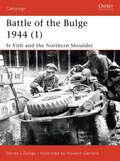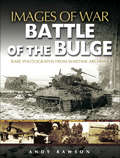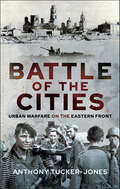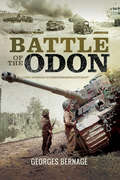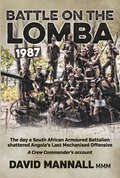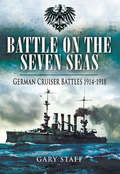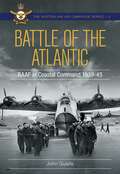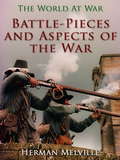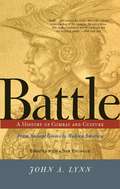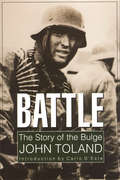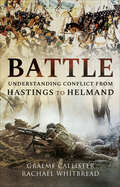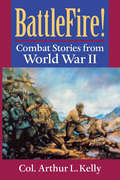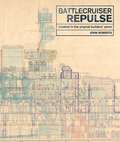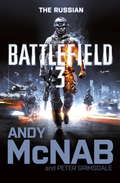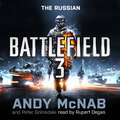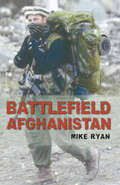- Table View
- List View
Battle of Pickett's Mill: Along The Dead Line (Civil War Series)
by Brad ButkovichThis Civil War history examines one of General Sherman devastating losses—a battle famously captured in Ambrose Bierce&’s The Crime at Pickett&’s Mill. On May 27, 1864, Union forces under the command of William Tecumseh Sherman attacked Confederate general Joseph E. Johnston and his men at Pickett&’s Mill in Paulding County, Georgia. Following his defeat at New Hope Church, Sherman ordered Major General Oliver Howard to attack Johnston's flank, which Sherman believed to be exposed. But the Confederate soldiers were ready, and Sherman's supporting troops never arrived. What ensued was a battle that cost 2,100 lives and a defeat that Sherman left completely out of his memoirs. In this detailed historical analysis, Brad Butkovich draws on personal letters, newspaper accounts and unit histories to bring to life the battle that Union soldier and author Ambrose Bierce called &“the Dead-Line.&”
Battle of Roanoke Island, The: Burnside and the Fight for North Carolina (Civil War Series)
by Michael P. ZatargaIn the winter of 1861, Union armies had failed to win any significant victories over their Confederate counterparts. The Northern populace, overwhelmed by the bloodshed, questioned whether the costs of the war were too high. President Lincoln despondently wondered if he was going to lose the Union. As a result, tension was incredibly high when Union hero Ambrose Burnside embarked for coastal North Carolina. With the eyes of the nation and world on little Roanoke Island in the Outer Banks, Burnside began his amphibious assault on the beaches and earned a victory that shifted control of Southern waters. Join author and historian Michael Zatarga as he traces the story of the crucial fight on Roanoke Island.
Battle of Surigao Strait (Twentieth-Century Battles)
by Anthony P. Tully&“[Tully] paints Admiral Nishimura's high-speed run into history with an entirely fresh palette of detail.&” —James D. Hornfischer, New York Times–bestselling author of Neptune&’s Inferno Surigao Strait in the Philippine Islands was the scene of a major battleship duel during the Battle of Leyte Gulf. Because the battle was fought at night and had few survivors on the Japanese side, the events of that naval engagement have been passed down in garbled accounts. Anthony P. Tully pulls together all of the existing documentary material, including newly discovered accounts and a careful analysis of US Navy action reports, to create a new and more detailed description of the action. In several respects, Tully's narrative differs radically from the received versions and represents an important historical corrective. Also included in the book are a number of previously unpublished photographs and charts that bring a fresh perspective to the battle. &“By giving a fuller view of the Japanese side, Tully's work forces a substantial revision of the traditional picture of the battle. Battle of Surigao Strait is not only military history based on scrupulous use of a plethora of new source materials, but is a spanking good read. Highly recommended.&” —War in History &“Tully has managed to trace the complicated flow of and reason for events on the nights of 24-25 October with a skill and aplomb that forces one to reconsider previously held views.&” —Naval History
Battle of Trafalgar: A Ladybird Expert Book (The Ladybird Expert Series #28)
by Sam WillisPart of the ALL-NEW LADYBIRD EXPERT SERIES'Packs plenty of heft into its slender page count' HISTORY REVEALED- Why was the Battle of Trafalgar such an important British victory in the Napoleonic Wars? - How did the British fleet show their strength against the French and Spanish? - How did Nelson excel in his final battle?FOLLOW the daring strategy and brilliant leadership of Horatio Nelson in Britain's stunning triumph against Napoleon's forces. From the might of Britain's war machine to the death of the world's most impressive naval commander, discover why Trafalgar remains the most famous naval battle in history.BRITAIN'S GLORIOUS VICTORY, AND NELSON'S FINAL BATTLEWritten by historian, archaeologist, and broadcaster Sam Willis, The Battle of Trafalgar is a gripping and accessible introduction to the battle that established Britain as a formidable seapower for many years to come.
Battle of Wills: Ulysses S. Grant, Robert E. Lee, and the Last Year of the Civil War
by David Alan JohnsonHistorians have long analyzed the battles and the military strategies that brought the American Civil War to an end. Going beyond tactics and troop maneuvers, this book concentrates on the characters of the two opposing generals--Robert E. Lee and Ulysses S. Grant--showing how their different temperaments ultimately determined the course of the war. As author David Alan Johnson explains, Grant's dogged and fearless determination eventually gained the upper hand over Lee's arguably superior military brilliance. Delving into their separate upbringings, the book depicts Grant as a working-class man from Ohio and Lee as a Virginia aristocrat. Both men were strongly influenced by their fathers. Grant learned a lesson in determination as he watched his father overcome economic hardships to make a successful living as a tanner and leather goods dealer. By contrast, Lee did his best to become the polar opposite of his father, a man whose bankruptcy and imprisonment for unpaid debts brought disgrace upon the family. Lee cultivated a manner of unimpeachable respectability and patrician courtesy, which in the field of battle did not always translate into decisive orders. Underscoring the tragedy of this fratricidal conflict, the author recounts episodes from the earlier Mexican war (1846-1848), when Grant and Lee and many other officers who would later oppose each other were comrades in arms. This vivid narrative brings to life a crucial turning point in American history, showing how character and circumstances combined to have a decisive influence on the course of events.From the Hardcover edition.
Battle of the Atlantic
by Marc MilnerWorld War II was only a few hours old when the Battle of the Atlantic, the longest campaign of the Second World War and the most complex submarine war in history, began with the sinking of the unarmed passenger liner Athenia by the German submarine U30. Based on the mastery of the latest research and written from a mid-Atlantic - rather than the traditional Anglo-centric - perspective, Marc Milner focuses on the confrontation between opposing forces and the attacks on Allied shipping that lay at the heart of the six-year struggle. Against the backdrop of the battle for the Atlantic lifeline he charts the fascinating development of U-boats and the techniques used by the Allies to suppress and destroy these stealth weapons.
Battle of the Atlantic: Gauntlet to Victory
by Ted BarrisThe Battle of the Atlantic, Canada’s longest continuous military engagement of the Second World War, lasted 2,074 days, claiming the lives of more than 4,000 men and women in the Royal Canadian Navy, the Royal Canadian Air Force and the Canadian merchant navy The years 2019 to 2025 mark the eightieth anniversary of the longest battle of the Second World War, the Battle of the Atlantic. It also proved to be the war’s most critical and dramatic battle of attrition. For five and a half years, German surface warships and submarines attempted to destroy Allied trans-Atlantic convoys, most of which were escorted by Royal Canadian destroyers and corvettes, as well as aircraft of the Royal Canadian Air Force. Throwing deadly U-boat “wolf packs” in the paths of the convoys, the German Kriegsmarine almost succeeded in cutting off this vital lifeline to a beleaguered Great Britain.In 1939, the Royal Canadian Navy went to war with exactly thirteen warships and about 3,500 regular servicemen and reservists. During the desperate days and nights of the Battle of the Atlantic, the RCN grew to 400 fighting ships and over 100,000 men and women in uniform. By V-E Day in 1945, it had become the fourth largest navy in the world. The story of Canada’s naval awakening from the dark, bloody winters of 1939–1942, to be “ready, aye, ready” to challenge the U-boats and drive them to defeat, is a Canadian wartime saga for the ages. While Canadians think of the Great War battle of Vimy Ridge as the country’s coming of age, it was the Battle of the Atlantic that proved Canada’s gauntlet to victory and a nation-building milestone.
Battle of the Bulge
by Steven J. ZalogaThe Battle of the Bulge was the last major German offensive in the West and the largest and the most costly battle fought by the US Army in World War II. Fought during the bitter winter of 1944-45, and resulting in over 100,000 German casualties and over 80,000 American casualties, it turned an apparent defeat into what British Prime Minister Winston Churchill called 'an ever-famous American victory'. Three armies attacked through the Ardennes, the weakest point in the American lines - and almost broke through. At St Vith and Elsenborn Ridge, Hitler, gambling everything in the hope that the residual might of the German army would not only force a breakthrough but would also split the Allied coalition in two, concentrated the bulk of his Panzer forces in the form of the Sixth Panzer Army. When the German advance here failed, Hitler switched the focus of the offensive to General Manteuffel's 5th Panzer Army in the south. Heavily attacked by superior German armor, outnumbered and without air support, the US army was on its own. The green US 106th Division held its own for a time, but then gave way in the biggest US surrender since Kasserine. German Panzers flooded towards the River Meuse. But at Bastogne their way was barred by the paratroopers of the 101st Airborne, the "Screaming Eagles". The ensuing battle of Bastogne would prove to be one of the most decisive battles of the war. In spite of its ultimate German failure, the Battle of the Bulge would have an important effect on the War and its aftermath: it slowed the Allies down, resulting in more territory being ceded to the Russian sphere of influence at the end of the War. This book on the decisive campaign of the war in northwest Europe provides a full account of the campaign strategy; the American and German forces and command; their equipment and tanks; and a detailed account of the fighting.
Battle of the Bulge 1944-45
by Andrew RawsonIn December 1944 the German military made its final attempt to end the Second World War by throwing in all its reserves in a desperate attempt to shatter the Allied lines. After breaking through the American-held sector in the Ardennes, two Panzer armies headed for the bridges over the River Meuse. However, a combination of poor planning, bad weather, tortuous terrain and, above all, the determined defence of keys towns and villages delayed the advance. The Allies were able to hold the northern and southern shoulders of the attack, hemming the Germans in. The Bulge had been created, and as the fortunes of battle were reversed, the Allies struck back.In Battle of the Bulge 1944–45, historian Andrew Rawson gives a clear, concise account of those dramatic days at the end of 1944, supported by a timeline of events and orders of battle. If you want to understand what happened and why – read on.
Battle of the Bulge 1944: 115
by Steven Zaloga Howard GerrardOsprey's first title examining the Battle of the Bulge, which was the largest and most costly battle fought by the US Army in World War II (1939-1945). The Ardennes fighting was Hitler's last gamble on the Western Front, crippling the Wehrmacht for the remainder of the war. In the first of two volumes on the Ardennes campaign Steven Zaloga details the fighting in the northern sector around St Vith and the Elsenborn Ridge. Sixth Panzer Army, containing the bulk of German Panzer strength, was expected to achieve the breakthrough here. It was the failure around St Vith that forced the Germans to look south towards Bastogne.
Battle of the Bulge: Rare Photogaphs from Wartime Archives (Images of War)
by Andy RawsonDramatic photographs of Nazi Germany’s shocking Ardennes Offensive that nearly turned the tide of World War II—from the author of In Pursuit of Hitler.Hitler’s desperate last throw during the depths of winter 1944/45 came perilously close to being a major disaster for the Allies. Their offensive through the Ardennes fell on the Americans and caught them totally by surprise. Unaccustomed to setbacks, the situation was for a time extremely serious and in some areas panic set in and events went out of control. It was only after the most bitter fighting and massive reinforcement that the rot was stopped. In this book the drama of those worrying weeks is captured in superb photographs.
Battle of the Cities: Urban Warfare on the Eastern Front
by Anthony Tucker-JonesA concise and vivid history of the urban war on the Eastern Front. The Stalingrad battle and the Leningrad siege were just two of the brutal, devastating urban conflicts that marked the awful struggle between Germany and the Soviet Union during the Second World War. The cities were strategic fixed points in the sweeping advances and retreats of the opposing armies across eastern Europe. Yet no one has concentrated on these city battles before or has sought to tell the story of the campaigns through the fighting that took place in and around them. That is Anthony Tucker-Jones’s purpose in this concise and vivid history of the urban war on the Eastern Front. Early in the war, during the Wehrmacht’s crushing offensives of 1941 and 1942, the Red Army was forced out of a series of key cities. Moscow was threatened, Leningrad surrounded. Then, after the climactic battle at Stalingrad, the Red Army with increasing confidence, speed and power drove the Germans from the Soviet and East European capitals they had occupied. The final urban battles were fought in Germany's cities, culminating in Berlin. As he traces the course of the fighting for each city, Anthony Tucker-Jones looks at the local circumstances, the opposing forces, the strategic significance and the tactics employed. He focuses not only on the destruction and cruelty of such warfare, but on the heroism displayed on both sides and on the fate of the civilians who found themselves on the front line.
Battle of the Odon
by Georges BernageThe Battle of the Odon evokes the clash between the British Army and the II SS-Panzer Korps, as they attacked across the Odon Valley during Operation "Epsom" in June 1944.Using contemporary photographs and documents, this book provides day-by-day details of the operation that was just one part of what is commonly referred to as the 'Battle of Normandy'.
Battle on the Lomba 1987: A Crew Commander's Account
by David MannallA South African national serviceman recounts becoming a soldier and an ensuing David-and-Goliath face-off against Angolan armed forces in 1987.The climactic death-throes of Soviet Communism during the 1980s included a last-gasp attempt at strategic franchise expansion in southern Africa. Channeled through Castro’s Cuba, oil-rich Angolan armed forces (FAPLA) received billions of dollars of advanced weaponry and thousands of armored vehicles. Their intent: to eradicate the US-backed Angolan opposition (UNITA), then push southwards into South Africa’s protectorate SWA/Namibia, ostensibly as liberators.1985 saw the first large-scale mechanized offensive in southern African history. Russian Generals planned and oversaw the offensive but didn’t account for the tenacity of UNITA (supported by the South African Defense Forces, SADF) or the rainy season. The ‘85 offensive floundered in the mud, and FAPLA returned to their capital Luanda. The South Africans stood down, confident their “covert” support for UNITA had demonstrated the folly of prosecuting war so far from home against Africa’s military Superpower. However, they were mistaken. Fidel and FAPLA immediately redoubled their efforts, strengthening fifteen battalions with even more Soviet hardware while Russian and Cuban specialists oversaw troop training.As Cuban and Angolan fighter pilots honed their skills over the skies of Northern Angola, David Mannall, a normal seventeen-year-old kid completing high school, was preparing for two years of compulsory military service before beginning Tertiary education. Through a series of fateful twists, he found himself leading soldiers in several full-scale armored clashes, including the largest and most decisive battle on African soil since World War II.This is a David and Goliath story that has never been truthfully told. The author reveals how Charlie Squadron, comprising just twelve 90mm AFVs crewed by thirty-six national servicemen, as part of the elite sixty-one Mechanized Battalion, engaged and effectively annihilated the giant FAPLA 47th Armored Brigade in one day—3 October 1987. Their 90mm cannons were never designed as tank-killers, but any assurances that it would never be used against heavy armor were left in the classroom during the three-month operation and never more starkly than the decisive “Battle on The Lomba River.” The Communist-backed offensive died that day along with hundreds of opposition fighters.47th Brigade survivors abandoned their remaining equipment, eventually joining the 59th Brigade in what became a full-scale retreat of over ten thousand soldiers to Cuito Cuanevale. The myth perpetuated by post-apartheid politicians goes something like this: “The SADF force that destroyed 47th Brigade on 3 October numbered 6,000 men and that all the hard yards were run by the long-suffering UNITA!” The inconvenient truth is that there were just 36 South African boys on the frontline that day, but it is also true to say they would never have achieved such a stunning victory without the support of many more. This is their story.
Battle on the Seven Seas: German Cruiser Battles, 1914–1918
by Gary StaffThe cruisers of the Imperial German Navy (Kaiserlische Marine) were active throughout the First World War and saw action all around the globe, tying up valuable Allied naval resources out of all proportion to their number. Drawing on firsthand accounts and original research in German archives, the author here describes in detail some of their most significant and/or audacious battles.Some are well known, such as their role at Jutland, Goeben's attack on the Russian fleet (which brought Turkey into the war) and the sagas of Konigsberg and Emden; but others have been unduly neglected. Gary Staff deliberately focuses on the latter to bring new material to the attention of the reader and to demonstrate the global span of the cruisers' activities. The blow-by-blow accounts of the action (drawing heavily on firsthand Allied and especially German accounts) are supported by dozens of photographs, many previously unpublished, from the author's own impressive collection.The battles described include: Helgoland Bight, August 1914; Coronel, November 1914; Falklands December, 1914; Doggerbank, January 1915; Goeben and the Russian fleet, Black Sea, May 1915; Ostergarn July 1915; Jutland, 1916; Second Heligoland Bight, November 1917; Imbros, January 1918.
Battle over the Atlantic: Royal Australian Air Force in Coastal Command 1939-1945
by John QuaifeAt the outbreak of World War II, somewhat by accident — and just as the first shots of the war were fired — young Australian airmen from the Royal Australian Air Force were engaged in operations that would become known collectively as the Battle of the Atlantic. Arguably lesser-known than air campaigns in other theatres, large numbers of Australians who volunteered for service with Royal Australian Air Force, found themselves fighting in this battle. Australians were there at the outbreak and many would go on to fly some of the final missions of the war in Europe. This book captures some of the experiences of the Royal Australian Air Force members who served with Coastal Command and, through the weight of numbers alone, stories of the Sunderland squadrons and the Battle of the Atlantic dominate the narrative. Being critical to Britain&’s survival, the battle also dominated Coastal Command throughout the war but Australians served in a surprising variety of other roles. The nature of many of those tasks demanded persistence that could only be achieved by large numbers of young men and women being prepared to &‘do what it took&’ to get a tedious and unrewarding job done. Over 400 did not come home.
Battle-Pieces and Aspects of the War: Civil War Poems (The World At War)
by Herman MelvilleBattle-Pieces and Aspects of the War (1866) is the first book of poetry published by American author Herman Melville. The volume is dedicated "To the Memory of the Three Hundred Thousand Who in the War For the Maintenance of the Union Fell Devotedly Under the Flag of Their Country" and its 72 poems deal with the battles and personalities of the American Civil War and their aftermath. (Excerpt from Wikipedia)
Battle: A History of Combat and Culture
by John A LynnBattle: A History of Combat and Culture spans the globe and the centuries to explore the way ideas shape the conduct of warfare. Drawing its examples from Europe, the Middle East, South Asia, East Asia, and America, John A. Lynn challenges the belief that technology has been the dominant influence on combat from ancient times to the present day. In battle, ideas can be more far more important than bullets or bombs. Carl von Clausewitz proclaimed that war is politics, but even more basically, war is culture. The hard reality of armed conflict is formed by - and, in turn, forms - a culture's values, assumptions, and expectations about fighting. The author examines the relationship between the real and the ideal, arguing that feedback between the two follows certain discernable paths. Battle rejects the currently fashionable notion of a "Western way of warfare" and replaces it with more nuanced concepts of varied and evolving cultural patterns of combat. After considering history, Lynn finally asks how the knowledge gained might illuminate our understanding of the war on terrorism.
Battle: The Story of the Bulge
by Carlo D'Este John Toland"The perspective of 15 years, painstaking research, thousands of interviews, extensive analysis and evaluation, and the creative talent of John Toland [paint] the epic struggle on an immense canvas. . . . Toland writes with the authority of a man who was there. . . . He tastes the bitterness of defeat of those who surrendered and writes as if he had the benefit of the eyes and ears of soldiers and generals on the other side of the line. . . . If you could read only one book to understand generals and GIs and what their different wars were like this is the book."—Chicago Sunday Tribune "The author has devoted years to studying memoirs, interviewing veterans and consulting military documents, both German and American. He also has revisited the old battlefields in Belgium and Luxembourg. . . . Toland has told the whole story with dramatic realism. . . . It is a story of panic, terror and of high-hearted courage."—New York Times Book Review "For the first time in the growing literature of World War II, the inspiring story of the stubborn, lonely, dogged battle of the Americans locked in this tragic salient is told. . . . gripping . . . You cannot put it down once you start it."—San Francisco Chronicle
Battle: Understanding Conflict from Hastings to Helmand
by Graeme Callister Rachael WhitbreadWhat are the critical factors that determine the outcome of battles? Which is more decisive in a clash of arms: armies or the societies they represent? How important is the leadership of the commanders, the terrain over which the armies fight, the weapons they use and the supplies they depend on? And what about the rules of war and the strategic thinking and tactics of the time? These are among the questions Graeme Callister and Rachael Whitbread seek to answer as they demonstrate the breadth of factors that need to be taken into account to truly understand battle. Their book traces the evolution of warfare over time, exploring the changing influence of the social, political, technological and physical landscape on the field of battle itself. They examine how the motivation of the combatants and their methods of fighting have changed, and they illustrate their conclusions with vivid, carefully chosen examples from across a range of Western European military history, including the Norman Conquest, the Hundred Years War, the Wars of Religion, the Napoleonic Wars and the world wars, and beyond. By exploring the wide range of interconnected factors that influence the results of battles, the authors broaden the study of this aspect of military history from a narrow focus on isolated episodes of conflict. Their original and thought-provoking writing will be fascinating reading for all students of warfare.
BattleFire!: Combat Stories from World War II
by Col. Arthur L. Kelly&“From Pearl Harbor to Leyte Gulf and Okinawa to Iwo Jima, the stories are presented as the individual soldiers, sailors, and marines lived them.&” —Gun Week Pearl Harbor, December 7, 1941: High on the bridge of the USS West Virginia Sfc. Lee Ebner was looking forward to the end of his watch and a relaxed Sunday morning breakfast. But the two low-flying planes painted with rising sun insignia and bearing down on the ship had other plans for him and his fellow seamen. Ten hours later, at Clark Field in the Philippines, Pfc. Jack Reed felt the brunt of another Japanese air attack and within weeks found himself a part of the gruesome Bataan Death March that was to claim the lives of hundreds of his comrades. On another continent, four years into the war, Capt. Benjamin Butler led his exhausted company up a steep, fog-shrouded Italian mountain toward a well entrenched German defensive position. The odds against their survival were appalling, though worse was to come in the months ahead. Such were the experiences of many young men-plucked from their local communities all across America, trained for war, and hurled into the strange reality of combat thousands of miles from home. In this stunning collection of World War II oral histories, Arthur Kelly recreates the experiences of twelve young men from Kentucky who survived the seemingly unsurvivable, whether in combat or as prisoners of war. &“A fascinating collection . . . A story of men at their best in the worst of times.&” —Louisville Courier-Journal &“This excellent book continues the current trend of exploring the individual soldier&’s experiences in World War II.&” —Military Review
Battlecruiser Repulse: Detailed in Original Builders' Plans
by John RobertsAn outstanding illustrated reference revealing the painstaking work of draftsmen in recording every detail of the famed British warship. The technical details of British warships were recorded in a set of plans produced by the builders on completion of every ship. Known as the &“as fitted&” general arrangements, these drawings represented the exact appearance and fitting of the ship as it entered service. Intended to provide a permanent reference for the Admiralty and the dockyards, these highly detailed plans were drawn with exquisite skill in multi-colored inks and washes that represent the acme of the draftsman&’s art. Today they form part of the incomparable collection of the National Maritime Museum at Greenwich, which is using the latest scanning technology to make digital copies of the highest quality. This book is one of a series based entirely on these drafts which depict famous warships in an unprecedented degree of detail—complete sets in full color, with many close-ups and enlargements that make every aspect clear and comprehensible. Extensive captions point the reader to important features to be found in the plans, and an introduction covers the background to the design. The subject of this volume was one of the last battlecruisers, elegant ships that combined a powerful armament with high speed, but were much criticized for their light protection. Throughout their existence, they were controversial—three were sunk at Jutland—and Repulse herself was famously lost to Japanese air attack at the outset of the Pacific War. Nevertheless, the type was highly prized: Repulse and her sister Renown were the only capital ships given sufficient priority to be designed, built, and completed during the course of the First World War, and substantial sums were spent on large-scale reconstruction during the 1930s. Both of these phases of the ship&’s life are fully documented in two separate sets of plans, which allow this novel form of anatomy to cover the whole life of the ship.
Battlefield 3: The Russian
by Peter Grimsdale Andy McNabAndy McNab at the top of his game, delivering pulse-pounding entertainment and awe-inspiring, widescreen action.Spetsnaz used to be a name to strike fear into the hearts of Russia's enemies. But now that the country has gone to the dogs, Dima Mayakovsky - once a revered figure inside the elite Special Forces unit - wants no part of it any more. But when a dangerous fugitive surfaces in Tehran, Dima is the man Kremlin wants to bring him in. There is no option: the ex-Spetsnaz legend must lead his team of battle-hardened operatives into combat, not something you can hide from the US recce satellites circling above.This means that Dima and his men become Marine Sergeant Henry 'Black' Blackburn's problem. As Iran descends into chaos, Dima and Black are forced to question everything they believed in, and to fight to survive, for their comrades, their honour and the lives of millions. They're on their own. And the clock is ticking?
Battlefield 3: The Russian (Battlefield #3)
by Peter Grimsdale Andy McNabSpetsnaz used to be a name to strike fear into the hearts of Russia's enemies. But now that the country has gone to the dogs, Dima Mayakovsky - once a revered figure inside the elite Special Forces unit - wants no part of it any more. But when a dangerous fugitive surfaces in Tehran, Dima is the man Kremlin wants to bring him in. There is no option: the ex-Spetsnaz legend must lead his team of battle-hardened operatives into combat, not something you can hide from the US recce satellites circling above.This means that Dima and his men become Marine Sergeant Henry 'Black' Blackburn's problem. As Iran descends into chaos, Dima and Black are forced to question everything they believed in, and to fight to survive, for their comrades, their honour and the lives of millions. They're on their own. And the clock is ticking?Read by Rupert Degas(p) 2011 Orion Publishing Group
Battlefield Afghanistan
by Mike RyanFrom interviews with his numerous contacts among the coalition forces stationed in Afghanistan, Mike Ryan has done what journalists have so far been unable to do.Battlefield Afghanistan is the first thorough-going account of the war in the former Taliban state: not the politics behind the conflict, but the actual situation for the men on the ground. Far from simply 'keeping the peace,' coalition forces in Afghanistan are currently involved in full-scale warfare with both al-Qaeda militants and the forces of the resurgent Taliban. Battlefield Afghanistan tells the real, inside story of the men under fire, based upon first-hand evidence from members of 3 Para, 16 Air Assault Brigade, the Royal Marines and the Special Forces community, together with the views and experiences of the US and French troops. As their accounts indicate, the hostilities faced have proved to be far greater than was anticipated, and the situation in Afghanistan far more serious than the politicians would like the public to realise.
